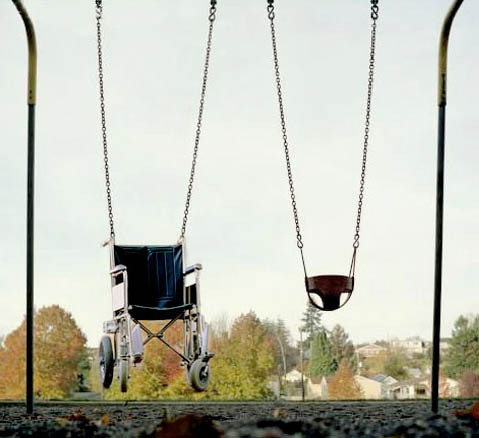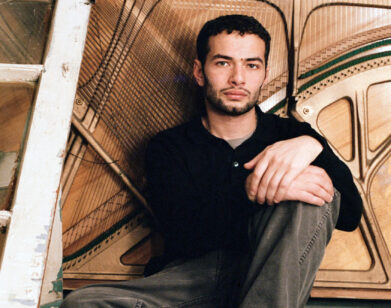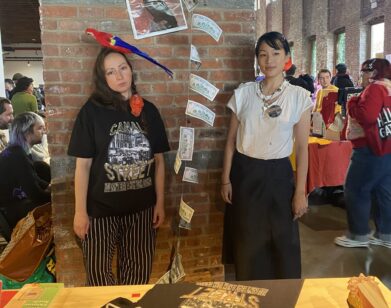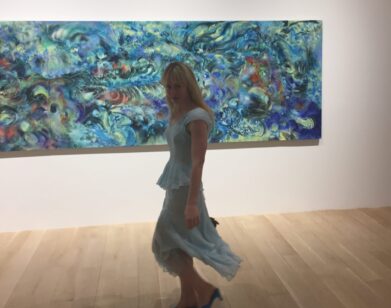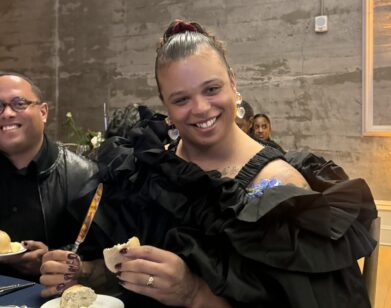Sebastian Errazuriz
Last december’s Design Miami fair was supposed to be all about celebrating surefire international design stars like the Campana Brothers or Ross Lovegrove (safe bets in a shaky market hoping to compete with the slightly less shaky art market). But out of nowhere, perched in Cristina Grajales’s New York gallery booth, a young upstart Chilean designer was hogging all of the spotlight. Suddenly people weren’t talking about the Campana Brothers or RossLovegrove. They were talking about a 31-year-old, born in Santiago and now living in New York, named Sebastián Errázuriz—or, more enigmatically, “Sebastián E,” as it was written on the gallery wall. The pieces on display included a long glass table with a base made out of an entire overturned Crespon tree, a wall shelf constructed from a fallen tree branch with books stacked along its twisting arms, even a taxidermy duck whose neck and head had been replaced by an adjustable desk lamp. (And let’s not forget his booklet of sketches for a motorboat coffin which suggest in their directional notes that one could sail out into the middle of a lake, drop the motor, and sink for eternity inside the wood box—“You only die once. Why not leave in style?” reads the sales pitch.) Was Errázuriz kidding? Was he trying to establish himself as the court jester of the design world? And if so, why were his pieces so somber and lyrical and rife with a certain eloquent environmental minimalism? The uninitiated were stymied. Cristina Grajales’s gallery experienced a bidding war.
The truth is, insiders have known about Errázuriz as an artist and a designer (and often confusingly both simultaneously) for a few years now. The multitasker moved from Chile to New York to attend NYU’’s fine arts masters program in 2006. In Chile, he was the scion of an eminent family and something of a local celebrity, mostly for his striking public art installations that once included planting a magnolia tree in the center of Chile’s National Stadium, in effect transforming the sports arena and former political torture grounds for dictator General Augusto Pinochet into a solemn public park for a single week. (He also put a cow rescued from the slaughterhouse out to graze on top of a downtown skyscraper and erected a crane strung with lights over the city like a giant night lamp.) But it’s been in New York where Errázuriz has taken his peculiar design sense—usually a mixture of death and comedy club—to the international stage. He’s made a fur coat out of teddy bears, belts out of belt buckles, and in one particularly ingenious design innovation, a stack of shelves like a set of wood-block piano keys that swivels from the wall when you want to put something on it. Errázuriz has the kind of self-confidence that ensures he will go the distance. His current plans include planting hundreds of white crosses in Central Park to resemble a military cemetery, the construction of a mountain of shredded dollar bills, more tree-based furniture, and a series of paintings depicting all of his ex-girlfriends. Here he talks with artist and mentor Ross Bleckner, who he met while attending NYU. If the two seem like they are sparring, it’s just a sign of mutual respect. After all, artists and designers are pros at pressing each other’s buttons.
ROSS BLECKNER: So tell me something I don’t know.
SEBASTIÁN ERRÁZURIZ: Uh, I don’t know either. That’s the whole thing—I have no idea what’s going to happen or how anything is going to go . . .
BLECKNER: That’s not a good answer. Tell me then what kind of design work you’re doing.
ERRÁZURIZ: I do limited-edition signed and numbered high-end furniture. Normally it’s for collectors who already own a Jeff Koons or an Andy Warhol or a Ross Bleckner and who want to continue filling their houses with amazing pieces. My furniture is mostly collected by people who know a lot about 20th-century design, but mainly it’s trying to give a twist to normal pieces. I like to twist normal objects.
BLECKNER: What do you mean by “give a twist to”?
ERRÁZURIZ: Well, it’s the idea of trying to make you look again at something basic.
BLECKNER: Do you think people really need to look again at a Jeff Koons or an Andy Warhol?
ERRÁZURIZ: No, I don’t necessarily think they need to. They’ve probably looked enough. But those are the people who my collectors tend to be—collectors of nice stuff. But for my design, I’m trying to make the viewer look again. BLECKNER: Well, I didn’t ask you about the market. We all know about luxury and the market. I asked you to tell me something I don’t know.
ERRÁZURIZ: I do hundreds and hundreds of sketches until I come up with ideas that somehow break a paradigm.
BLECKNER: What kind of paradigm? A paradigm about your feelings? About the history of design?
ERRÁZURIZ: It can be a bit of both, but in general, it’s getting back to looking. So, for example, we’ve been making tables out of trees for centuries, right? Why not make a table using a whole tree? Why do you really have to cut down the tree if the tree is beautiful in itself. What if you just tipped the tree over, de-rooted it, and placed it horizontally? It could work as the base of the table.
BLECKNER: Two questions: One, aren’t you still cutting the tree down?
ERRÁZURIZ: I am, but I’m doing it in a different way. It’s not an ecologically friendly approach I’m after.
BLECKNER: Two, has no one ever done that before?
ERRÁZURIZ: Apparently no one has. I try to Google every idea I have. Normally I go up to page 40 in Google, and if by then nothing has appeared, I want to think that it just doesn’t exist.
BLECKNER: That it’s fresh . . .
ERRÁZURIZ: Yeah, that it’s fresh. If it’s not fresh, I’d rather not do it. Then there are other design exercises that I take on that are just about plain aesthetics or about answering technical problems . . . like, how do you make a chaise lounge that looks like it should tip over and break but is in complete counter-balance.
BLECKNER: I know a lot of artists whose work—as much as they call it sculpture—could also be used functionally, and vice versa. You might say that they’re designers, too, even though they prefer being called artists.
ERRÁZURIZ: I consider myself an artist first and a designer second. But at the end of the day, the amount of meaning you can throw onto a functional piece can tend to be limited—especially in design.
BLECKNER: Because first and foremost you need it to be useful?
ERRÁZURIZ: Yes, you need it to have a function that’s established. When something turns out to be a piece of art, it has enough layers to overcome its functionality. That’s very tricky to do with a piece that’s simply design. It’s only when the layers overpass the functionality that it falls into the area of art.
BLECKNER: So how can you make the distinction between art and design?
ERRÁZURIZ: I get lost in the crossover sometimes because I enjoy both. Here’s an example: I just made a secretaire in honor of my grandfather. It’s an 1880 French secretaire you could use to put all of your stuff in, but it’s been re-adapted to have a vault in the main compartment. It’s a stainless steel vault, and inside it there’s a real skull embedded in acrylic. Now, this piece, for me, is talking about my grandfather’s rituals—how until his last days he would go through his files in his cabinets, files which none of us knew what they were about. For me, that was a mystery, and it was linked to death, so it was important for me.
BLECKNER: He was getting ready, tidying up after himself.
ERRÁZURIZ: Yeah, probably. So if you open up this piece you can see and remember death. If you leave it closed, it’s just drawers that you can put whatever you want in. I don’t know where the line is here between art and design. For me, it’s working in both areas. And I like being in that kind of murky water.
BLECKNER: Now tell me a little about yourself. Where are you from?
ERRÁZURIZ: I’m from Chile. I’m a weird mix. I come from some sort of aristocratic family, but at the same time my parents decided to be hippies. My father pursued a career in art, so we never really had that much money. What we had was education.
BLECKNER: What does an aristocratic family consist of in Chile? A family with money, power, prestige, education?
ERRÁZURIZ: It’s a bit of all that. My family had three presidents and two archbishops. So it’s a family with a certain tradition, even in a little South American country. The only thing interesting about my life is that it is completely filled with contradictions. I have this aristocratic heritage, but I don’t really have any money, so I’ll always be struggling. I wanted to be an artist all my life, but I didn’t consider myself worthy of being an artist, so I went into design.
BLECKNER: When did you get into design?
ERRÁZURIZ: Some 10 years ago. I studied design in school. Then I moved into film courses, back into design, and jumped over into sculpture. BLECKNER: Were you making objects this whole time?
ERRÁZURIZ: Yes, and somehow because of this struggle between art and design, my design started getting a lot of attention. That might be because of my whole crisis about wanting to be an artist but not daring to, so I put my efforts into design.
BLECKNER: Give me an example of an early piece.
ERRÁZURIZ: I did a fur coat made completely out of teddy bears. You could say that it was just a clever little exercise. I was making pieces that weren’t necessarily commercial. I mean, there are only so many people who can wear a fur coat made out of teddy bears. I don’t know that I would even dare to walk out into the street in that piece. [laughs] So from the beginning, all of the exercises were about a bit of a humor situation.
BLECKNER: There was humor in all of your works?
ERRÁZURIZ: A lot. Maybe humor was a way out. Maybe it was some sort of democratic leveler.
BLECKNER: But you’ve done a number of projects and performances, too. You put a cow on the top of a building in Santiago. You put a tree in the middle of the stadium there. Do you consider that part of your design work? Or do you not even think about classifying what it is?
ERRÁZURIZ: For me, that’s art. Some pieces are 100 percent design, others 100 percent art. Others, I have no idea. I have tried to separate them, but, if you go through my note pads, all of the pages are tangled up together. You’ll have a little design piece followed by an idea for an art project.
BLECKNER: In your mind do you keep the work separate? It’s not like you’re trying to finance your installation art with your design work, right?
ERRÁZURIZ: Obviously, with installation art you don’t really get that much money, unless you apply for a government grant, and when you do that they normally give you some sort of restrictions—especially in South America. So for me it was a lot easier to fund my own pieces. In a sense, my design work would get nice prices, so I could fund my artwork and have the liberty of working on these public installations the way that I wanted to.
BLECKNER: So it’s a nice circle you’ve established then, huh?
ERRÁZURIZ: The only problem is that the circle closes itself, and I’m always left with no money. All of my money goes back into the art. But it’s nice to have independence and to think you can do more and more of the projects in your sketch pad.
BLECKNER: Do you feel that is happening?
ERRÁZURIZ: I feel it has. For instance, I just showed my Duck Lamp in Miami. I once found this taxidermy duck outside a museum that had its neck broken. I don’t know how I thought that it should have a classic architectural lamp arm to stand in for its neck and head, but I did. I mean, I’m from a very traditional South American family. It’s weird to tell your mom, “I’m putting a lamp on a stuffed duck.” It sounds pretty psycho, but I was compelled to do it. It takes balls to present it and say, “You know what? I like this. I don’t know why, but it fascinates me.”
BLECKNER: When I met you, you had just come to New York and you seemed very self-confident. How has that self-confidence born out now that you’ve been in New York for a few years?
ERRÁZURIZ: I’ve been battered around and punched really hard, but I’m still super-confident.
BLECKNER: Is that just part of the process?
ERRÁZURIZ: I think it is. Back in Chile, at one point, I had my own TV show, my own radio show, my own newspaper column, all sorts of things. I could grab a phone and make things happen. I arrived here and I really wanted to work with certain people and get my projects out, but it’s like coming to the Olympics.
BLECKNER: You mean it’s not like that in Chile? [laughs]
ERRáZURIZ: Chile has its own rules, but it’s different. For example, a few years ago I was at the White Cube gallery in London. I was trying to get the people at the front desk to see my portfolio. I had no idea that you can’t just appear at the front desk as an artist and expect people to look at your work. It has to be someone else who introduces you, someone else to present you . . .
BLECKNER: Right.
ERRáZURIZ: So I spent a half hour trying to chat up these girls and be as charming as I could, and it was no use. At some point I figured out I was wasting my time, fucking up, and I went home—alone.
BLECKNER: So you regrouped and came up with a new tactic for getting someone to see your work?
ERRáZURIZ: That’s the weird thing—you really can’t.BLECKNER: Well, obviously someone’s seen it by now—you’re doing this interview.
ERRáZURIZ: Of course I’m grateful for everything that’s happening and all of the confidence people have in me. But that’s one thing I’ve learned: You just can’t go out and seek stuff. They’re supposed to find you, which is pretty fucked up because, how do you stay inside your studio waiting for someone to come over and check your work?
BLECKNER: You don’t.
ERRáZURIZ: So how do you do it? You’re the artist. You’re the one who’s been here for years.
BLECKNER: I think it works a little of both ways. [pauses] Initially it develops through other artists, ones you admire and respect, who see your work and whose work you see—and that’s probably how it happened with you.
ERRáZURIZ: I guess you’re right. You were my teacher a couple of years ago, and now I’m getting you to interview me. [laughs]
BLECKNER: Tell me some designers who have influenced you over the years.
ERRáZURIZ: I normally prefer artists as influences for my work. But Mark Mullin is a great designer. Philippe Starck, Ross Lovegrove . . . they’re amazing. They’re all people who I studied at some point and who today I’m lucky enough to show next to. It’s a huge honor, but my personal view of design takes a different path. I’m more into a Duchampian search with looking . . .
BLECKNER: I don’t know what that means.
ERRáZURIZ: I mean, there’s only so much that you can do with aesthetics and techniques. At the end of the day, you get to some sort of mathematical juggling act. I can make a beautiful piece, a beautiful design, but beauty’s not enough. It doesn’t do it for me.
BLECKNER: So Duchampian translates as what for you?
ERRáZURIZ: The tree, for example. It’s just simply more beautiful than anything I could make on my own.
BLECKNER: It’s the found object.
ERRáZURIZ: A pre-existing object is already charged with so much information and so much beauty. When you’re working with an object that is already so intense, a single flick of the wrist can take it in a completely different direction. Sometimes I think you can achieve things that are beyond what any one individual can do if you establish nature or life as a stronger force than yourself.
BLECKNER: Because of the element of surprise?
ERRáZURIZ: No, the element of life. I have some pieces that are really beautiful in terms of balance, color, aesthetics, and materials. But they are just nice. The other pieces—like the tree table—are the ones that really have life in them. They have that extra twist I was talking about.
BLECKNER: Which others?
ERRáZURIZ: I’ve made a new branch shelf. It’s a branch I found in the street. I thought, If I can work with this branch and twist it around, I
can turn it into an amazing piece.
BLECKNER: I was always impressed with the way you come about your ideas and how you develop your projects in your studio out of your notes.
ERRáZURIZ: Why?
BLECKNER: Well, for one, because you bring a lot of information to a piece, a lot of confusing thoughts, and basically you distill them into a few really beautiful objects—I’m talking about your furniture and your installation work. To me, your work is like a reserved surrealism. It’s not over the top. There’s a kind of restraint. That’s what gives it its mystery. One last question: You come from South America. How does that affect what you do? Is there something particularly Latin about your work?
ERRáZURIZ: You know, I think there’s still this cheesy, weird niceness. At the end of the day, I still come from this small country, so I’m a very warm, loving person. I’m still used to kissing people, and I have to apologize here because I’m supposed to shake their hands instead.
BLECKNER: Are those the characteristics of Latin-American art: nice, kissy, warm?
ERRáZURIZ: I think they might be . . . At the end of the day, I’m pretty fucking innocent. BLECKNER: I think you are well-intentioned, Sebastián, but I wouldn’t call you innocent.
ERRáZURIZ: Well, I’m not dumb. I’m a clever guy.
BLECKNER: [laughs] That’s different.
ERRÁZURIZ: But I still hope for good. I still would want to sacrifice for important things.
BLECKNER: All that’s very general. Are you making paintings these days as well?
ERRÁZURIZ: Yeah, I’m actually doing a couple of paintings with a friend. I’m painting all of my ex-girlfriends with her . . . I work a lot with death and, I guess, in a way they’re all dead. They’re all people who at some point were super-important to me, and I forget them and live on. It’s kind of like taking out that box with their pictures and letters and placing them on the wall and living with them. I’m also painting myself as Saint Sebastian.
BLECKNER: Well, I guess that goes back to the confidence that I noticed.
ERRÁZURIZ: My dad used to place me in front of the Saint Sebastian painting at the National Gallery in London as a kid.
BLECKNER: He had high hopes for you, I suppose.
Ross Bleckner is a New York City-based artist.

